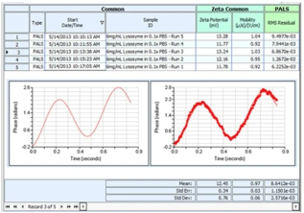Electrostatic repulsion of colloidal particles is often the key to understanding the stability of any dispersion. Brookhaven Instruments NanoBrook ZetaPALS provides a simple, easy measurement of the electrophoretic mobility. The NanoBrook ZetaPALS features the ability to measure zeta potential by traditional electrophoretic light scattering (ELS) and a newer method known as Phase Analysis Light Scattering (PALS).
Both ELS and PALS methods for zeta potential measurements use a specialized palladium based electrode in which an alternating voltage is applied that causes the particles of one charge to move towards the electrode of the opposite charge. The velocity of the movement is determined by forward light scattering collected at 15o angle. Typically, the higher the velocity the greater the charge of the particle.
The PALS methods was developed based theories formulated at Bristol University and introduced into the market by Brookhaven Instruments. The PALS method is a 1000 times more sensitive than traditional light scattering techniques based on the shifted frequency spectrum. With the PALS method, a particle only needs to move a fraction of its’ own diameter ,making this method ideal for samples that have a very low mobility. Low mobility can be the result of particles dispersed in oily or unusually viscous media, weakly charged samples near their isoelectric points, or samples in which a field strength of 1-2 V/cm can be generated.
The table below shows a variety of difficult to measure samples, all of which were easily measured with the NanoBrook. Some were measured in high salt concentration; some in low dielectric constant non-polar solvents; and one in a viscous liquid. Electrophoretic mobilities determined with the NanoBrook Zeta PALS (units 10-8 m2 /V·s).
|
Sample
|
PALS Result
|
Literature Value
|
Comments
|
|
NIST 1980
|
2.51 ± 0.11
|
2.53 ± 0.12
|
Electrophoretic mobility standard
|
|
Blood Cells
|
-1.081 ± 0.015
|
-1.08 ± 0.02
|
Dispersed in physiological saline
|
|
Fe2O3
|
-0.013 ± 0.0015
|
NA
|
Dispersed in dodecane
|
|
TiO2
|
0.255 ± 0.010
|
NA
|
Dispersed in toluene - not dried
|
|
TiO2
|
0.155 ± 0.011
|
NA
|
Dispersed in toluene - dried
|
|
TiO2
|
-0.503 ± 0.015
|
NA
|
Dispersed in ethanol
|
|
Casein
|
-0.025 ± 0.002
|
NA
|
Dispersed in PEG - viscous
|
|
SiO2
|
-0.73 ± 0.04
|
NA
|
Dispersed in 2.0 M KCI - High salt
|
The PALS method is a versatile technique that does not require the application of large electric fields which may result in unwanted sample heating or degradation. The PALS method can be used with particles in a solution that has a high ionic concentration (up to 3M) or sample conductivity of up to 220mS/cm. The high salt tolerance of the PALS method makes it ideal for samples prepared at physiological ionic strength such as with a phosphate buffer solution(PBS).
Electrophoretic Light Scattering (ELS) Features
•Zeta potential measured with high accuracy in low salt aqueous media
•Ability to resolve simple multimodal distributions
•Can extrapolate Isoelectric Point from pH titrations
Phase Analysis Light Scattering (PALS) Features
•For proteins, peptides, antibodies, nucleotides, and other biological samples
•For high salt, organic solvents & viscous media
•1000x more sensitive than other techniques*
•Can extrapolate Isoelectric Point from pH titrations

|
Specifications
|
|
|
Size range suitable for zeta measurement
|
1nm to 100 μm, sample dependent
|
|
Mobility Range
|
10-11 to 10-7 m2 /V*s
|
|
Zeta potential range
|
-500 mV to 500 mV, sample dependent
|
|
Signal Processing
|
Electrophoretic (ELS) & true Phase Analysis Light Scattering (PALS)
|
|
Maximum sample conductivity
|
220 mS/cm, covering saline and PBS solutions for proteins
|
|
Precision
|
± 3%, depending on salt concentration
|
|
Temperature control range
|
-5 °C to 110 °C, ± 0.2 °C
|
|
Condensation Control
|
Purge facility using dry air, nitrogen preferred
|
|
Standard laser
|
40 mW solid state laser, nominal 640 nm wavelength
|
|
Detection Angle
|
15°
|
|
Data Presentation
|
Doppler Frequency Shift, electrophoretic mobility, zeta potential using Smoluchowski, Hückel, or Henry
|
|
Power Requirements
|
100/115/220/240 VAC, 50/60 Hz
|
|
Dimensions
|
23.3 x 42.7 x 48.1 cm
|
|
Weight
|
15 kg
|
|
Environmental Characteristics
|
Temperature 10 °C to 75 °C; Humidity 0% to 95%, non-condensing
|
|
CE Certificate
|
Class I laser product, EN 60825-1:2001, CDRH
|